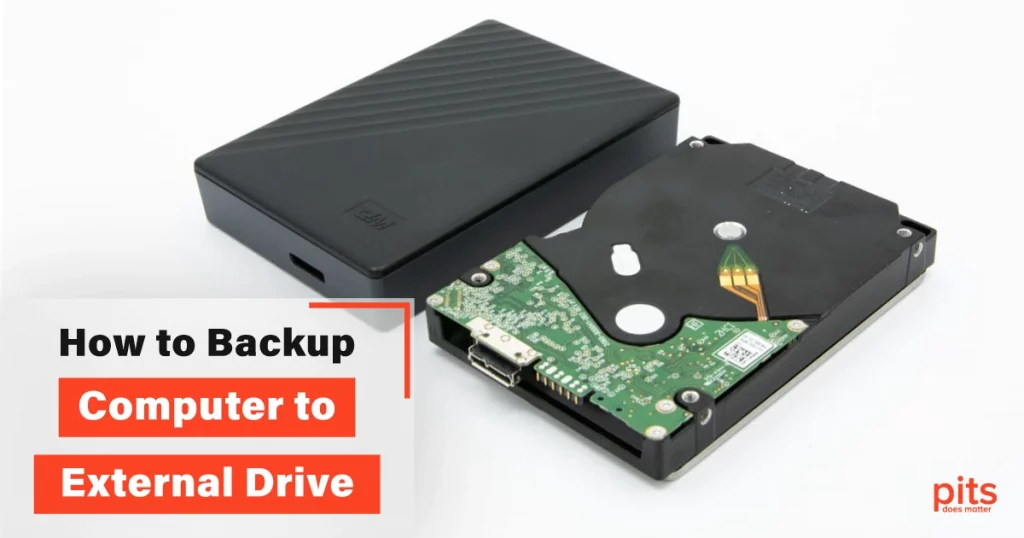Backing up your computer is essential to safeguard your data against unexpected loss or corruption. An external drive is one of the easiest and most convenient ways to back up your data. In this blog, our team will walk you through the steps to back up your computer to an external hard drive.
Back Up Your Computer to Portable Drive
Choose the Right External Hard Drive
The first step is to choose a backup drive that will suit your needs. Look for an external hard drive with ample storage capacity. You want to ensure it is large enough to hold all your data, including files, photos, and documents.
Another important point to consider is the type of connection that the external hard drive uses. Most modern computers support USB 3.0, which offers faster data transfer speeds than USB 2.0. If your computer only supports USB 2.0, consider getting an external hard drive that supports both USB 2.0 and 3.0.
Connect the External Hard Drive
Once you have chosen the external hard drive, the next step is to connect it to your computer. Connect the external drive to your desktop or laptop computer using the cable provided with the drive. In most cases, you must connect the drive to a USB port on your computer.
Choose the Backup Method
Next, you must choose the backup method you want to use. There are two main methods to back up your data to an external hard drive: manual and automatic backup.
- Manual backup involves copying files from your computer to the external hard drive one by one. This method is time-consuming and requires you to remember to perform backups regularly.

- Automatic backup involves setting up a backup schedule that runs automatically at specified intervals. This method is more convenient and ensures that your data is backed up regularly without any effort.
Most modern operating systems, such as Windows and macOS, have built-in backup software for automatic backups. You can also use third-party backup software to set up automatic backups.
Set Up the Backup
Once you have chosen the backup method, the next step is to set up the backup. If you are using the built-in backup software in your operating system, you must follow the prompts to set up the backup schedule and choose the folders and files you want to back up.
If you are using third-party backup software, you will need to install the software and follow the prompts to set up the backup. Most backup software allows you to choose the backup schedule, the files and folders to back up, and other settings.
Perform the Backup
After you have set up the backup, the next step is to perform the backup. If you are using manual backup, you must copy the files and folders you want to back up to the external hard drive.
If you are using automatic backup, it will run automatically at the specified intervals and regularly back up your important files. You can also initiate a backup manually if you want to back up your data immediately.
Verify the Backup
After completing the backup process, it is important to verify that the backup was successful. To verify the backup, check that all the files and folders that you wanted to back up are present on the external hard drive. You can also open some of the files to ensure they are intact.
Verifying your backups regularly is a good idea to ensure your data is protected. It is also important to test your backups by restoring some files to your computer to ensure the backup works correctly.
How to Keep your Data Backup Safe
Backing up your computer to an external hard drive is essential to protect your data against unexpected data loss or file corruption. By following these steps, a user can ensure that data is safe and secure. Remember to choose an external hard drive with ample storage space and a connection type that is compatible with your computer.

Decide on the backup method, like external media or cloud backup, that works best for you and set up the backup schedule and files to be backed up. Finally, do not forget to verify and test your backups regularly to protect your data.
One additional tip is to keep your external hard drive in a safe and secure location when not in use. This will protect it from physical damage or theft.
Consider creating multiple backups and keeping them in different locations, such as a cloud storage service or another external hard drive.
Backing up your computer to an external hard drive is a simple and effective way to safeguard your data. It is a crucial step in protecting your personal and professional information. It is never too late to start. By following these steps, you will ensure that your data is secure and accessible when you need it.
Frequently Asked Questions
What kind of external hard drive should I use for backing up my computer?
You can use any external hard drive with sufficient capacity to store your data. Look for a drive that is reliable, fast, and has enough space to hold all of your files. USB 3.0 or Thunderbolt connections are recommended for fast data transfer speeds.
How do I back up my computer to an external hard drive on a Mac?
On a Mac, you can use Time Machine to back up your computer to an external hard drive. Simply connect the drive, open Time Machine preferences, and select the drive as your backup destination. Time Machine will automatically back up your files on a regular basis.
How do I back up my computer to an external hard drive on Windows?
On Windows, you can use the built-in Backup and Restore feature to back up your computer to an external hard drive. Connect the drive, open Backup and Restore, and select Set up backup to choose the files and folders you want to back up. Then, select the external hard drive as your backup destination.
How often should I back up my computer to an external hard drive?
It’s recommended that you back up your computer on a regular basis, such as daily, weekly, or monthly, depending on how often you use your computer and how important your files are. It’s a good idea to back up your computer before making any major changes, such as upgrading your operating system or installing new software.
